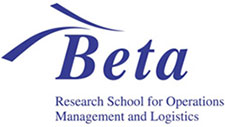On Friday, 23 September 2022, Jelle Adan will defend his PhD thesis Operational Decision Making in Semiconductor Manufacturing. This thesis has been supervised by Geert-Jan van Houtum and Alp Akcay. The ceremony will take place at the Eindhoven University of Technology, in Atlas 0.710, at 13:30.
Summary
Semiconductor manufacturers face a continuous pressure to improve the efficiency of their production processes. To remain competitive, digitization as well as the automation of knowledge work have become part of the main strategy of enterprises – a global trend enabled by increased data collection, computer power and connectivity, that is often referred to as the fourth industrial revolution or Industry 4.0. The semiconductor manufacturing process constitutes a large number of steps. The first series of steps are referred to as the frond-end manufacturing process and the final steps as the back-end process. Most briefly, the frond-end concerns wafer fabrication. A wafer is a disk made of semiconducting material that contains up to thousands of integrated circuits (ICs). Next, in the back-end process, these ICs are encapsulated in a supporting case to prevent physical damage and corrosion. The entirety is controlled by hierarchical management layers. While aiming at targets set by higher management layers, the operational management layer oversees the manufacturing execution. The focus of this work is on the decision making in the operational management layer at back-end manufacturing. Prior to manufacturing, raw materials need to be allocated to match demand. These materials often come in fixed batch sizes. Mainly due to quality concerns, it is common policy to prevent the accumulation of partially consumed batches, i.e., a batch is consumed completely or any leftover is discarded. The mismatch between demand and allocated materials is called overallocation. The most precious materials in the back-end process are the wafers. A wafer contains ICs of various classes, whereas demand is usually for a specific class, introducing additional constraints and making the allocation problem more challenging. In Chapter 2, an integer linear program for the class-constrained wafer allocation problem is provided, along with an extension to allow more allocation flexibility. A real-world case study is conducted to show the benefit of the proposed method compared to current practice and to quantify the value of extended allocation flexibility. When raw materials are allocated, the next decisions concern the assignment of work to the available equipment. In common scheduling terminology, the semiconductor back-end production environment presents an unrelated parallel machine scheduling problem with sequence and machine dependent setup times and eligibility constraints. Chapter 3 presents a hybrid genetic algorithm specifically targeted to solve realistic (large) problems, with the objective to minimize the makespan. The main novelties of this algorithm are that it is lean, as it employs a minimal number of parameters and operators which eases calibration, and that it is enhanced with local search procedures specifically targeted at large instances. An extensive comparative study shows that the proposed method outperforms existing methods and demonstrates that calibration is crucial. Maintenance is critical for all equipment to prevent the occurrence of unexpected breakdowns. In practice, decisions regarding maintenance actions are made separate from production scheduling. From a production scheduling point of view, maintenance is simply a period during which a machine is unavailable for production. Since both production and maintenance activities utilize the available time of machines, it can be highly beneficial to align these tasks and to schedule them in an integrated manner. Chapter 4 addresses an integrated scheduling problem that originates from practice and which is new in the literature. A mixed integer program is formulated and a hybrid genetic algorithm is proposed to solve realistic (large) scale instances. The potential of simultaneously scheduling production and maintenance is quantified through a case study based on real-world data. When a schedule is communicated to the shop floor it may be (close to) optimal, however, given that this is a highly stochastic environment, this may no longer be the case only several hours or days later. To correct this, the shop floor must provide feedback on the exact progress of the schedule. On the short term, this feedback can trigger re-optimization, whereas on the long term, realizations of past decisions can enable better decisions in the future. The latter is the focus of Chapter 5. Historical production data is collected, cleaned and used to train multiple well-known ML techniques to predict processing times. When these predictions are used by the schedulers from Chapter 3 and 4, this can potentially lead to better scheduling decisions and increased efficiency.
